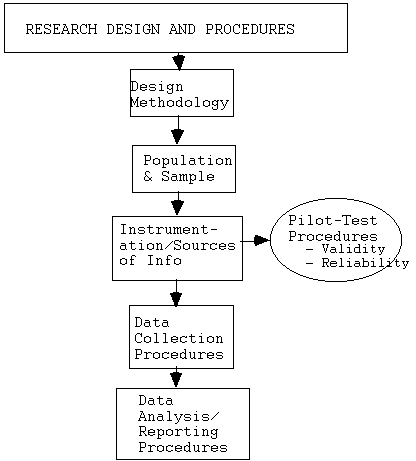|
EDR720
: The Class
: Methodology
: Design
: Online Reading
|
|||||||
|
Electronic Textbook - According to Its Own Design: Research Design Methodology "Population and Sampling" is but one subpart of the overall
master plan: research design and procedures. The "who"
(or more grammatically correct, with whom) of population and sampling
is generally preceded by the "how:" the blueprint,
or design methodology. That will be our major topic this time out!
 I. Research Design & Procedures: The Key Components WARNING! The following terms are often confused by novice researchers:
TIP: "Research Design and Procedures" is the major subheading - it will drive a good chunk of your all-important prospectus Chapter 3! And it contains the other two components! Flow Chart of the Key Components of the Research Design and Procedures  Please note the following key characteristics of the above flowchart:
As you saw in our initial handout on "What Is A Doctoral Research Proposal?" the design methodology narrative consists of chaining together any/all relevant buzzwords that characterize overall "blueprint" your particular research study. Therefore, this subsection is as "lean and mean" as our "Statement of the Problem:" ideally a single sentence (although it may need to be broken up into two or more sentences just for readability), identifying the methodology buzzwords that correspond to your study. ***: In order to give us all a common base and frame of reference, I'd urge you at this time to study the EDR 610 Intro to Research Module 4 / materials. These web pages identify, define and illustrate the various "families" of design methodology labels and how certain design terms "link to" certain related keywords of your problem statement. These are as follows:
Please study or review these materials and of course, please let me know if you should have any questions! * Some dissertation writers like to include a brief rationale as to why a given methodologic label pertains to their particular study. That is: they not only tell what the study is under methodology - the buzzword or label itself - but also why that particular label "fits." This is fine and even advisable, particularly in the case of the relatively 'new' qualitative design terminology. I also like to see a brief rationale in the case of ex post facto/causal comparative designs. This helps me to see that you understand the "after-the-fact," non-experimental nature of this particular type of methodology, and how it is different from the true experimental designs. As long as such rationale is focused and brief, it is fine for your Design Methodology sub-sub-heading! But I would caution against getting "too carried away." I've seen some (well-intended! and perhaps a bit insecure - believe me, I know that feeling ... !) dissertation writers cross the line into several paragraphs or even pages of such rationale. Before they know it, they find themselves citing narrative and authors of several research books in what is meant to be a brief and focused rationale. One way to compromise on this issue is the following: write up a brief rationale in your Design Methodology subsection. If your chair and/or committee members need for you to 'defend' this particular choice of term, let it emerge in the questioning during your prospectus hearing (or proposal meeting if your chair goes the formal-meeting route for the proposal). If and when you are indeed questioned in this manner, my advice to you would then be to ask if your chair and/or committee members would like to see such rationale (that you've just verbally discussed) expanded in the written narrative for Chapter 3. More often than not, they won't need a lengthy write-up; they just wanted to ask you in the meeting to be sure that you, and they, understood exactly what you are doing and why. But if they do prefer such written elaboration, you will have had a golden opportunity to find this out! Again, my cardinal rule here prevails: when in doubt, ask your chair if he/she has a preference! My own advice, which seems to be the preference of most if not all chairs with whom I've worked, is to focus on lean and mean "what" (design terms) and only very brief rationale. … Biggest mistake I see made here! is in not pinning down all of the relevant design methodology 'buzzwords' that may be pertinent to your study! Perhaps this happens because (subconsciously, at least) you may be thinking: "one design term per study." But it is very rare for this to be the case. In fact, I can't think of a single instance where at least two or three, and even more, terms applied to a given dissertation topic - especially considering all of the sub problems. By carefully rereading Intro to Research Module 4, Lessons #1 and #2, you'll probably come to realize that the design terms are far from "mutually exclusive:" that is, there is considerable interrelationship and overlap possible regarding a given study. As you'll also probably see from these two lessons, many of them "naturally go together" as well. The "methods person(s)" on your committee will take a careful look at these, matching your stated design terms to your problem statement, sub problems, etc. - and by dialoguing with you, 'draw out' some more possibilities of relevant design labels that you might not have thought of. (You guessed it: that's what I do...! I speak from experience!) * Another common point of confusion: "DESIGN" vs. "ANALYSIS." Occasionally I'll see someone tell me their "methodology" is "analysis of variance," or "focus group interviewing" or "chi square."
Analysis Once you have finished you should: Go on to Assignment 1: Your Design Methodology E-mail M. Dereshiwsky
at statcatmd@aol.com
Copyright © 1999
Northern Arizona University |